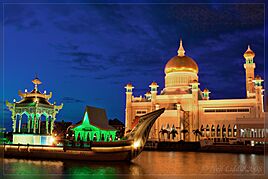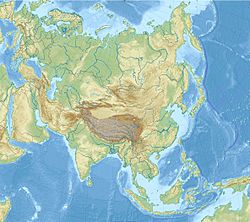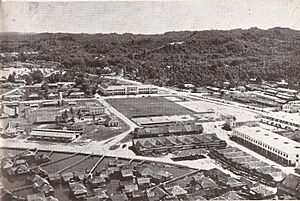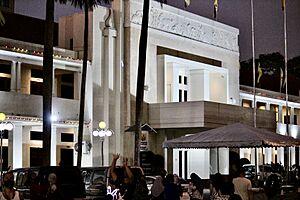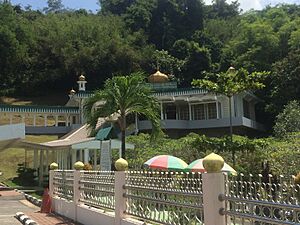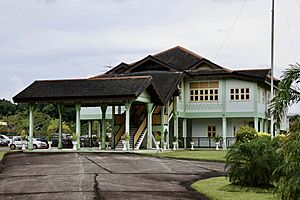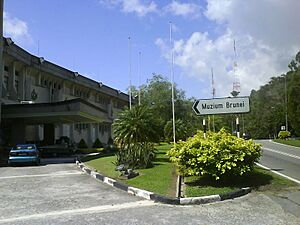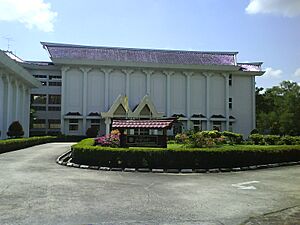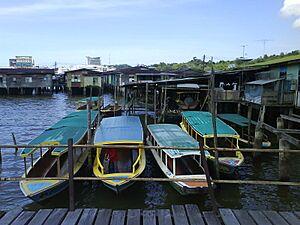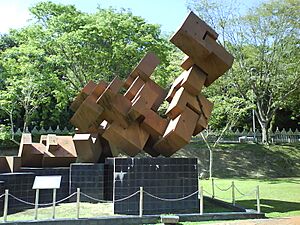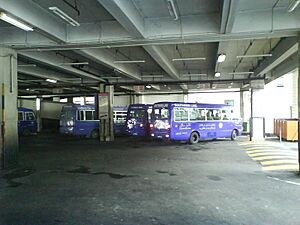Bandar Seri Begawan facts for kids
Quick facts for kids
Bandar Seri Begawan
بندر سري بڬاوان (Jawi)
|
||
|---|---|---|
|
Capital and municipal area
|
||
|
Omar Ali Saifuddien Mosque
Gadong commercial area
Jame' Asr Hassanil Bolkiah Mosque
Kampong Ayer
The Mall Gadong
|
||
|
||
| Nicknames:
The Venice of the East
Bandar Brunei |
||
|
OpenStreetMap
|
||
| Country | Brunei | |
| District | Brunei-Muara | |
| Bruneian Empire | 7th–18th century | |
| Settled by the British | 19th century | |
| Land development by the British | 1906 | |
| Resettlement of the Sultanate of Brunei administration centre | 1909 | |
| Sanitary Board area | 1921 | |
| Municipal area (present-day) | 1935 | |
| Government | ||
| • Body | Bandar Seri Begawan Municipal Department | |
| Area | ||
| • Total | 100.36 km2 (38.75 sq mi) | |
| Population | ||
| • Estimate
({{{pop_est_as_of}}})
|
100,700 | |
| Demonyms | Seri Begawanese Orang Bandar |
|
| Time zone | UTC+8 (BNT) | |
| Area code(s) | +673 2 | |
Bandar Seri Begawan (pronounced BAHN-dahr SUH-ree BUH-gah-wahn), often called BSB, is the capital and largest city of Brunei. It's a special municipal area covering about 100 square kilometers (38.7 square miles). In 2007, about 100,700 people lived there.
This city is part of the Brunei-Muara District, which is the smallest but most populated area in Brunei. More than 70% of the country's people live here. Bandar Seri Begawan is Brunei's main city and its only official city. It's where the government works, and it's also a busy place for business and culture. The city was known as Brunei Town until 1970. It was renamed to honor Sultan Omar Ali Saifuddien III, who was the 28th Sultan of Brunei and the father of the current Sultan, Hassanal Bolkiah.
The history of Bandar Seri Begawan began with a Malay village built on stilts over the Brunei River. This village was the start of what is now Kampong Ayer. From the 16th century, it became the capital of the Bruneian Sultanate. In the 19th century, it became a British protectorate. In the 20th century, the British helped develop the land, and people slowly moved from the water village to live on land. During World War II, the city was taken over by Japanese forces in 1941 and bombed in 1945 by Allied forces. Brunei became fully independent from the British on January 1, 1984, in the city center.
Bandar Seri Begawan is home to Istana Nurul Iman, which is the largest residential palace in the world. It also has the Omar Ali Saifuddien Mosque, a famous landmark in Brunei. Another amazing place is Kampong Ayer, known as the world's largest 'water village' and nicknamed the "Venice of the East." The city also hosted big events like the 20th Southeast Asian Games in 1999 and the 8th APEC Summit in 2000.
Contents
What's in a Name?
The word "Begawan" was used for Bruneian rulers who had given up their throne. It comes from an old Sanskrit word meaning "god." "Seri Begawan" means "blessed one" in Sanskrit. "Seri" comes from the Sanskrit word "Sri," which is a title of respect. "Bandar" comes from Persian and means "harbor" or "port." In the Malay language, "bandar" means "town" or "city."
The city was named after Sultan Omar Ali Saifuddien III. He was the 28th Sultan of Brunei and the father of the current Sultan, Hassanal Bolkiah. "Seri Begawan" was part of the special title given to the late sultan when he stepped down from the throne in 1967. The city was renamed on October 4, 1970, to remember his efforts to make the country modern. Before this, the city was called Brunei Town or Bandar Brunei in Malay. It is the only city in Brunei with "bandar" in its official name.
Locals often just call the capital "Bandar," which means "The City." This name might refer to the city center or even the wider urban areas around it.
A Look Back in Time
People have lived in Brunei since the sixth and seventh centuries. There was a Malay trading center and fishing port near where the city is today. The first settlements on the Brunei River banks date back to the eighth century. These were like the stilt houses of Kampong Ayer, close to the Brunei Museum.
During the Bruneian Empire (15th–17th centuries), the Sultanate ruled parts of Borneo and even the southern Philippines. The water settlement near the city became the main center for the government. When the Sultanate became less powerful in the 18th century, the number of people living there dropped.
From 1888 until 1984, Brunei was protected by the British. In 1906, the British encouraged people to move to land on the western side of the river. In 1899, the first oil well was drilled near Bandar Seri Begawan, but no oil was found. Later, oil was found in other parts of Brunei. In 1909, Sultan Muhammad Jamalul Alam II built a new palace on the west bank. Chinese traders also arrived, helping the economy grow. By 1920, a mosque and government buildings were built. That same year, the new settlement became the capital and a municipal area.
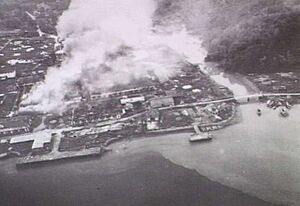
However, the city's growth was stopped when the Japanese took it over in 1941. The Allied forces took it back in 1945. During the war, many buildings were destroyed by bombing. After the war, the British started rebuilding Brunei.
In 1950, Sultan Omar Ali Saifuddien III worked with the British to increase taxes from oil. This helped Brunei get more money for development. A five-year plan was started in 1953 to build new roads and buildings. With the growth of the oil and gas industry, the capital began to change. Many public buildings were built, and a central business area developed in the 1970s and 1980s. On August 1, 2007, Sultan Hassanal Bolkiah approved expanding the city from 12.87 square kilometers (4.97 square miles) to 100.36 square kilometers (38.75 square miles).
How the City is Run
City Management
Bandar Seri Begawan is managed by the Bandar Seri Begawan Municipal Board. This board is part of the Ministry of Home Affairs. The Municipal Board started in 1921 as a "Sanitary Board," which was in charge of keeping Brunei Town clean. In 1935, it became a full "municipality." Bandar Seri Begawan is a city in practice, but officially it's a municipality, just like the towns of Tutong, Kuala Belait, and Seria.
The city is in the Brunei-Muara District. This district is the smallest but has the most people in Brunei. Since August 1, 2007, the city area has grown from 12.87 square kilometers (4.97 square miles) to 100.36 square kilometers (38.75 square miles). This area includes many different villages and smaller areas.
The traditional stilt settlement on the Brunei River, called Kampong Ayer, is made up of several of these villages. Local leaders and village chiefs in the capital are chosen by the people who live there.
Where is Bandar Seri Begawan?
Bandar Seri Begawan is located at 4°53'25"N, 114°56'32"E, on the northern bank of the Brunei River.
Weather in Bandar Seri Begawan
Brunei has a hot and wet tropical rainforest climate. It rains a lot throughout the year. The northeast monsoon brings rain from December to March, and the southeast monsoon from June to October. The most rain ever recorded in one day was 662.0 mm (26.06 inches) on July 9, 2020.
| Climate data for Bandar Seri Begawan (Brunei Airport) (1991–2020 normals, extremes 1972–2020) | |||||||||||||
|---|---|---|---|---|---|---|---|---|---|---|---|---|---|
| Month | Jan | Feb | Mar | Apr | May | Jun | Jul | Aug | Sep | Oct | Nov | Dec | Year |
| Record high °C (°F) | 35.5 (95.9) |
36.7 (98.1) |
38.3 (100.9) |
37.6 (99.7) |
36.7 (98.1) |
36.2 (97.2) |
36.2 (97.2) |
37.6 (99.7) |
36.9 (98.4) |
35.4 (95.7) |
34.9 (94.8) |
36.2 (97.2) |
38.3 (100.9) |
| Mean daily maximum °C (°F) | 33.0 (91.4) |
33.4 (92.1) |
34.3 (93.7) |
34.5 (94.1) |
34.8 (94.6) |
34.5 (94.1) |
34.7 (94.5) |
35.1 (95.2) |
34.6 (94.3) |
33.9 (93.0) |
33.6 (92.5) |
33.5 (92.3) |
35.7 (96.3) |
| Daily mean °C (°F) | 27.0 (80.6) |
27.2 (81.0) |
27.6 (81.7) |
28.0 (82.4) |
28.1 (82.6) |
27.9 (82.2) |
27.7 (81.9) |
27.8 (82.0) |
27.6 (81.7) |
27.2 (81.0) |
27.2 (81.0) |
27.2 (81.0) |
27.5 (81.5) |
| Mean daily minimum °C (°F) | 22.1 (71.8) |
22.4 (72.3) |
22.7 (72.9) |
22.8 (73.0) |
22.8 (73.0) |
22.6 (72.7) |
22.4 (72.3) |
22.4 (72.3) |
22.3 (72.1) |
22.3 (72.1) |
22.6 (72.7) |
22.5 (72.5) |
21.4 (70.5) |
| Record low °C (°F) | 18.4 (65.1) |
18.9 (66.0) |
19.4 (66.9) |
20.5 (68.9) |
20.3 (68.5) |
19.2 (66.6) |
19.1 (66.4) |
19.4 (66.9) |
19.6 (67.3) |
20.5 (68.9) |
18.8 (65.8) |
19.5 (67.1) |
18.4 (65.1) |
| Average precipitation mm (inches) | 320.6 (12.62) |
162.9 (6.41) |
143.4 (5.65) |
241.8 (9.52) |
260.3 (10.25) |
237.7 (9.36) |
241.8 (9.52) |
231.5 (9.11) |
235.1 (9.26) |
313.6 (12.35) |
322.9 (12.71) |
358.9 (14.13) |
3,065.9 (120.70) |
| Average precipitation days (≥ 1.0 mm) | 18.0 | 12.0 | 13.0 | 16.0 | 18.0 | 17.0 | 17.0 | 17.0 | 18.0 | 21.0 | 22.0 | 22.0 | 211.0 |
| Average relative humidity (%) | 86 | 85 | 84 | 84 | 85 | 84 | 84 | 83 | 84 | 85 | 86 | 86 | 85 |
| Mean monthly sunshine hours | 214.3 | 209.1 | 230.0 | 239.2 | 239.1 | 216.5 | 223.8 | 225.4 | 197.2 | 211.1 | 216.6 | 204.2 | 2,422.2 |
| Source 1: World Meteorological Organisation, | |||||||||||||
| Source 2: Deutscher Wetterdienst (extremes, 1971–2012 and humidity, 1972–1990) | |||||||||||||
Who Lives in Bandar Seri Begawan?
In 2011, about 20,000 people lived in Bandar Seri Begawan. The larger metropolitan area had around 279,924 people. Most people in Brunei are Malays. The Chinese are the largest minority group. There are also several native groups like the Bisaya and Dusun. Many foreign workers live in Brunei and its capital, mostly from Malaysia, Thailand, the Philippines, Indonesia, and India.
Cool Places to Visit
Mosques
- Omar Ali Saifuddien Mosque – Built in 1958, this mosque has a golden dome and beautiful Italian marble inside. It's thought to be one of the world's most beautiful mosques.
- Jame' Asr Hassanil Bolkiah Mosque – This is the largest mosque in Brunei. It was built to celebrate the Sultan's 25th year of ruling. Locals call it the Kiarong mosque.
- Al-Ameerah Al-Hajjah Maryam Mosque – This green mosque is located near Jalan Jerudong.
- Ash-Shaliheen Mosque – This mosque is next to the prime minister's office. Its design is inspired by famous mosques in Saudi Arabia and Spain.
Historical Sites
- The tombs of past sultans Bolkiah and Sharif Ali are in Kota Batu.
- The Royal Wharf is a historic area by the water.
The Secretariat Building
The Secretariat Building is the oldest government building. It was once the main office for the government.
The Royal Ceremonial Hall or Lapau
The Lapau is used for important royal ceremonies. Sultan Hassanal Bolkiah was crowned here on August 1, 1968. The inside is decorated with amazing gold. Near the Lapau is the Dewan Majlis, where the legislative assembly used to meet. Visitors need special permission to enter.
The Royal Mausoleum
This is where many sultans and royal family members are buried. It has been used since 1965. The remains of the last ten sultans are inside the Mausoleum.
Istana Darussalam
This was the former home of Sultan Omar Ali Saifuddien III and the birthplace of the current Sultan, Hassanal Bolkiah. It was built in the 1940s and looks like a traditional Malay stilt house. It's now a protected monument and a tourist spot, but you can't go inside.
Museums
- Brunei Museum – This is the largest museum in Brunei. It opened in 1972 and shows Islamic history, natural history, Brunei artifacts, and information about the country's oil industry.
- Malay Technology Museum – This museum opened in 1988. It shows traditional Malay technologies and ways of life.
- Royal Regalia Museum – This museum is dedicated to Sultan Hassanal Bolkiah. It displays his coronation chariots, gold and silver ceremonial items, and royal jewelry. You can also see documents about the Sultan's life and Brunei's history.
- Brunei History Centre – Opened in 1982, this center researches Brunei's history, especially the family tree of the sultans and royal family.
- Brunei Stamp Gallery – This new attraction is inside the post office building.
- Bubungan Dua Belas – This "House of Twelve Roofs" was built in 1906. It used to be the home of British officials in Brunei. Now, it's a gallery showing the long relationship between Brunei and the United Kingdom.
- The Arts and Handicrafts Centre – Opened in 1980, this center teaches traditional Bruneian arts like silverware, brassware, woodcarving, and weaving.
Istana Nurul Iman
The Istana Nurul Iman palace is where the Sultan of Brunei lives. It's about 3 kilometers (1.9 miles) southwest of the city center. Its name means "Palace of the Light of Faith" in Arabic. The palace has 1,788 rooms, 257 bathrooms, and a huge banquet hall for up to 5,000 guests. It only opens to the public for three days each year during the Hari Raya Adilfitri celebration.
Kampong Ayer
The city includes Kampong Ayer, a famous "water village" where houses are built on stilts. It stretches about 8 kilometers (5 miles) along the Brunei River. This village is over 1,000 years old and is considered the largest stilt settlement in the world, with about 30,000 residents and 2,000 houses. An explorer named Antonio Pigafetta called it the "Venice of the East" when he visited Brunei in 1521.
Parks and Trails
The Waterfront
This new area in Bandar Seri Begawan looks out over the historic Kampong Ayer. It's about 1.8 hectares (4.4 acres) and took almost three years to build. It opened on May 28, 2011, and is open 24 hours a day for people to enjoy the views and outdoor cafes.
Persiaran Damuan
This park was created in 1986. It has a display of sculptures from different ASEAN countries. The 1-kilometer (0.62-mile) long park has nice walkways and views of Pulau Ranggu, an island with two types of monkeys, including the special proboscis monkey found only in Borneo. You can also get great views of the Istana Nurul Iman from here.
Jalan Tasek Lama
This is a popular walking trail for city residents, just a few minutes from the city center. It has well-made paths, benches, picnic spots, a waterfall, and ponds with water lilies.
Bukit Subok Recreational Park
This park offers great views of Kampong Ayer and downtown Bandar Seri Begawan. It has a wooden walkway with viewing huts where you can enjoy the scenery.
Youth Centre
The Pusat Belia is the youth center in the capital. It was opened on December 20, 1969. It has a large hall for 1,000 people, a gymnastics hall, an Olympic-sized swimming pool, and separate hostels for boys and girls.
Getting Around
By Land
Buses connect the capital to the western part of Brunei. You can reach the Temburong area by driving over the Sultan Haji Omar Ali Saifuddien Bridge. Before this bridge opened in 2020, you had to travel through Sarawak in Malaysia.
The main bus station is in Jalan Cator, under a multi-story car park. There are six bus routes in Bandar Seri Begawan. Buses usually run from 6:30 AM to 6:00 PM, but some services go later. All bus routes start and end at the main bus terminal. Buses to other towns like Tutong and Seria also leave from here. You can also find taxicabs.
By Air
The Brunei International Airport serves the entire country. It's about 11 kilometers (6.8 miles) from the city center and can be reached in 10 minutes by highway. Royal Brunei Airlines, the national airline, has its main office in the city.
By Water
'Penambang' are water taxis used to travel between downtown Bandar Seri Begawan and Kampong Ayer. They are the most common way to get around the water village. You can find them at many "docking parts" along the Brunei River. Fares can be negotiated. Regular water taxi services also go to Temburong and Malaysian towns like Limbang and Labuan.
What the City Makes
The city produces things like furniture, textiles, handicrafts, and timber.
Shopping Spots
Brunei has many places to shop:
- Gadong Central has many shopping malls, shops, and restaurants. You can find The Mall Gadong and local fast food chains here. There's also a night market called Pasar Malam Gadong.
- Serusop Complex has smaller shopping malls near Brunei International Airport.
- Rimba Point is a medium-sized mall with a supermarket.
- Tungku-link Commercial Complex has various shops, restaurants, and textile stores.
- Beribi Complex.
- Kiulap Commercial Precinct has Kiulap Mall, colleges, banks, and many restaurants.
- Abdul Razak Complex and Seri Complex are in Jalan Raja Isteri Pengiran Anak Saleha.
- Aman Hill Shopping Mall is in Sg. Tilong.
- Huaho Mall is in Kg. Manggis.
- One City Mall is in Kg. Salambigar, Sg. Hancing.
Traditional Markets
Tamu Kianggeh
This open market has many small businesses selling local vegetables, fruits, live chickens, fish, plants, and food.
Pasar Pelbagai Barangan Gadong / Pasar Malam (Night Market)
This market is near the Mall Gadong. It's similar to Tamu Kianggeh but focuses more on selling foods like sate, soto, and local dishes such as Nasi katok and ambuyat. You can also find fruits and wooden handicrafts. During the day, local plant sellers are here.
Learning in Bandar Seri Begawan
You can find all levels of education in Bandar Seri Begawan, from kindergarten to university.
Primary and Secondary Schools
There are many primary and secondary schools, both government and private. The Ministry of Education sets the curriculum for most schools.
- Raja Isteri Girls High School: This is an all-girls' government secondary school built in 1957. It's one of the oldest secondary schools and the first for girls in the country.
Religious Schools
There are also religious schools for Muslim students. These include primary religious schools and Arabic preparatory schools. There's also a special secondary religious school, Institut Tahfiz Al-Qur'an Sultan Haji Hassanal Bolkiah, which trains students to memorize the Quran. The Ministry of Religious Affairs sets the curriculum for these schools.
Sixth Form Centres
The city has two sixth form centers (for pre-university studies). Duli Pengiran Muda Al-Muhtadee Billah College offers general studies, while Hassanal Bolkiah Boys' Arabic Secondary School is for students from Arabic religious schools.
Universities and Colleges
Technical and Vocational Education
You can get technical and vocational training at two campuses of the Institute of Brunei Technical Education (IBTE) and the main campus of Brunei Polytechnic. Some private schools also offer diploma and certificate courses.
Higher Education
Two of Brunei's four national universities are in the capital. Sultan Sharif Ali Islamic University offers degrees in Islamic studies. Seri Begawan Religious Teachers University College trains teachers for Islamic religious schools. The other two universities, University of Brunei Darussalam and University of Technology Brunei, are located just outside the city.
There are also two private colleges, International Graduate Studies College and Laksamana College of Business, which offer bachelor's degree programs.
International Connections
Many countries have their embassies or consulates in Bandar Seri Begawan. These include Australia, Bangladesh, China, France, Germany, India, Indonesia, Japan, Malaysia, New Zealand, the Philippines, Russia, Saudi Arabia, Singapore, South Korea, Thailand, the United Kingdom, and the United States.
Sister Cities
Bandar Seri Begawan has "sister city" relationships with several cities around the world:
 Nanjing, China
Nanjing, China Tangerang, Indonesia
Tangerang, Indonesia South Tangerang, Indonesia
South Tangerang, Indonesia Jakarta, Indonesia
Jakarta, Indonesia Bangkok, Thailand
Bangkok, Thailand Kuala Lumpur, Malaysia
Kuala Lumpur, Malaysia Tokyo, Japan
Tokyo, Japan New York City, United States
New York City, United States Washington, D.C., United States
Washington, D.C., United States London, United Kingdom
London, United Kingdom Taipei, Taiwan
Taipei, Taiwan Manila, Philippines
Manila, Philippines
Images for kids
-
Memorial depicting 60 in Arabic, to commemorate the Sultan Hassanal Bolkiah's 60th birthday
See also
 In Spanish: Bandar Seri Begawan para niños
In Spanish: Bandar Seri Begawan para niños


